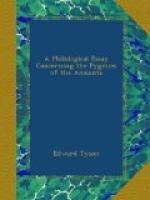[Footnote C: Problemes Geographiques. Les Peuples Etrangers chez les Historiens Chinois. Extrait du T’oung-pao, vol. iv. No. 4. Leide, E.J. Brill.]
Passing to the north-west of the Andamans, we find in India a problem of considerable difficulty. That there were at one period numerous Negrito tribes inhabiting that part of Asia is indubitable; that some of them persist to this day in a state of approximate purity is no less true, but the influence of crossing has here been most potent. Races of lighter hue and taller stature have invaded the territory of the Negritos, to a certain extent intermarried with them, and thus have originated the various Dravidian tribes. These tribes, therefore, afford us a valuable clue as to the position occupied in former days by their ancestors, the Negritos.
In some of the early Indian legends, De Quatrefages thinks that he finds traces of these prehistoric connections between the indigenous Negrito tribes and their invaders. The account of the services rendered to Rama by Hanuman and his monkey-people may, he thinks, easily be explained by supposing the latter to be a Negrito tribe. Another tale points to unions of a closer nature between the alien races. Bhimasena, after having conquered and slain Hidimba, at first resisted the solicitations of the sister of this monster, who, having become enamoured of him, presented herself under the guise of a lovely woman. But at the wish of his elder brother, Youdhichshira, the king of justice, and with the consent of his mother, he yielded, and passed some time in the dwelling of this Negrito or Dravidian Armida.
It will now be necessary to consider some of these races more or less crossed with alien blood.
In the centre of India, amongst the Vindyah Mountains, live the Djangals or Bandra-Lokhs, the latter name signifying man-monkey, and thus associating itself with the tale of Rama, above alluded to. Like most of the Dravidian tribes, they live in great misery, and show every sign of their condition in their attenuated figures. One of this tribe measured by Rousselet was five feet in height. It may here be remarked that the stature of the Dravidian races exceeds that of the purer Negritos, a fact due, no doubt, to the influence of crossing. Farther south, in the Nilgherry Hills, and in the neighbourhood of the Todas and Badagas, dwell the Kurumbas. and Irulas (children of darkness). Both are weak and dwarfish, the latter especially so. They inhabit, says Walhouse,[A] the most secluded, densely wooded fastnesses of the mountain slopes. They are by popular tradition connected with the aboriginal builders of the rude stone monuments of the district, though, according to the above-mentioned authority, without any claim to such distinction. They, however, worship at these cromlechs from time to time, and are associated with them in another interesting manner. “The Kurumbas of Nulli,” says Walhouse, “one




